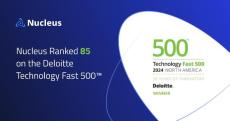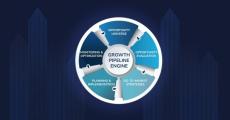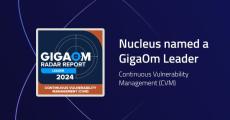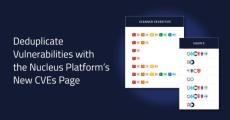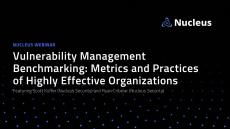|
By Nucleus
Customers can now ingest scorecard data directly into their Nucleus Security projects.
|
By Steve Carter
We’ve had a lot to celebrate at Nucleus this year, with today’s news being the being one of our most significant achievements of the year. Speaking for the whole company, we are proud to have been named to the Deloitte Technology Fast 500, a ranking of the 500 fastest growing technology companies in North America for 2024, and for the recognition of our 1,562% growth over the past three years.
|
By Nucleus
Growing vulnerability and risk management market offers partners significant growth opportunity.
|
By Aaron Unterberger
As organizations continue to embrace digital transformation, their infrastructure increasingly spans cloud environments, third-party integrations, and remote work setups. This shift enhances efficiency and productivity—but also broadens the digital attack surface, creating new points of exposure to the public internet.
|
By Scott Kuffer
Managing compliance in federal IT is a critical and complex task, especially when it comes to addressing findings from security assessments. One of the key tools to bridge the gap between requirements and the current state is the Plan of Action and Milestones (POA&M). Required by federal security frameworks like the Federal Information Security Modernization Act (FISMA) and NIST 800-53, POA&Ms are used to document security weaknesses, outline mitigation plans, and track their resolution.
|
By Nucleus
Nucleus Security Launches POAM Process Automation for Federal Agencies Integrated solution helps federal agencies and their suppliers reduce operational overhead, maintain compliance, and promote risk management efficacy.
|
By Corey Tomlinson
In September 2024, Frost & Sullivan released its Frost Radar: Application Security Posture Management (ASPM), 2024, highlighting the leaders in this rapidly growing market. We’re proud to be recognized as a top player, reflecting our strong growth and impact in the ASPM space. Our customers use Nucleus to achieve a comprehensive and unified application security posture.
|
By Corey Tomlinson
As organizations face increasingly sophisticated cyber threats, the importance of Continuous Vulnerability Management (CVM) continues to grow. GigaOm’s latest Radar Report for Continuous Vulnerability Management provides an in-depth analysis of the current landscape, offering a comprehensive look at the solutions and vendors leading the charge in this critical space. The report assesses a variety of platforms based on key criteria such as feature set, ease of use, performance, and innovation.
|
By Scott Kuffer
At Nucleus Security, our goal has always been to deliver an intuitive and scalable vulnerability management platform. A critical part of this mission is ensuring that its user interface (UI) evolves to meet our customers’ needs. I’m pleased to announce that we recently rolled out an updated UI—an important first step in a series of planned improvements aimed at enhancing our users’ experience with the Nucleus platform.
|
By Rob Gibson
Vulnerability management is often a complex task, particularly when using multiple scanning tools or dealing with the constant flow of new CVEs. Different scanners can uncover the same vulnerability but provide different insights or look at different metadata, making it look like one vulnerability is several without the proper context. We are excited to introduce the Nucleus CVEs Page, designed to enhance how your organization manages vulnerabilities across projects.
|
By Nucleus
In this Nucleus webinar, our panel of cybersecurity experts delves into the complexities and best practices for Risk-Based Vulnerability Management (RBVM) in modern organizations. Led by co-founder Scott Kuffer, the discussion covers the evolution of RBVM, the importance of a unified data approach, the role of automated tools, and effective metrics for vulnerability management. Insights from Cecil Pineda, Gregg Martin, and Steve Carter provide a comprehensive look at strategies for mitigating risks and improving security posture through enhanced vulnerability management processes into 2025.
|
By Nucleus
In this demo of Nucleus Security's integration with SecurityScorecard, learn how users can set up, manage, and leverage this connection for enriched vulnerability and asset data.
|
By Nucleus
In this Nucleus webinar, we take a deep dive into the practical challenges and strategies for managing security debt in the context of Risk-Based Vulnerability Management (RBVM). Scott Kuffer, co-founder of Nucleus Security and veteran in vulnerability management, explains how RBVM has shifted from a holistic risk reduction approach to a prioritization-heavy process that often falls short. He discusses why traditional methods lead to excessive security debt and demonstrates how aligning VM processes with product management principles can create more efficient, business-centric remediation.
|
By Nucleus
In this webinar, discover how the Nucleus Vulnerability Intelligence Platform (VIP) is changing the way organizations handle vulnerabilities. Learn how VIP empowers security teams to assess, prioritize, and mitigate vulnerabilities in real time by leveraging automated workflows, comprehensive data aggregation, and custom risk ratings. Key topics covered: Chapters Don't forget to like, comment, and subscribe for more in-depth webinars and expert discussions on cybersecurity and vulnerability management!
|
By Nucleus
How should we measure risk? Zebra Technologies has more than a dozen cybersecurity tools, thirty-five teams, and hundreds of people worldwide managing vulnerabilities. They wanted to measure with one yardstick; use a single, risk-based solution that could be customized to meet business criteria.
|
By Nucleus
Join us for an in-depth webinar on the Exploit Prediction Scoring System (EPSS), a powerful tool for predicting the exploitability of vulnerabilities. This discussion features experts Jay Jacobs from Cyentia and Stephen Schafferr from Peloton Interactive. They explore the intricacies of EPSS, its application, and the benefits of using EPSS over traditional methods like CVSS for better vulnerability management. Key topics include operationalizing EPSS, leveraging threat intelligence, and creating effective prioritization strategies. .
|
By Nucleus
Join Scott Kuffer, Co-Founder of Nucleus Security, in this webinar, focused on effective vulnerability management. Dive deep into the complexities of managing non-CVE based vulnerabilities. Learn about centralized vs. distributed remediation strategies and gain practical tips on triaging, prioritizing, and responding to vulnerabilities. This webinar emphasizes the importance of a unified approach to vulnerability management, leveraging threat modeling, and re-evaluating risk assessment methodologies to protect your business.
|
By Nucleus
Steve Carter, CEO and co-founder of Nucleus Security, and Dr. Nikki Robinson, Security Architect at IBM, discuss the importance of the people side of vulnerability management. They explore challenges such as context switching, long mean time to remediation, and the impact of communication on vulnerability management programs. The conversation includes practical advice on incorporating human factors into cybersecurity practices, how to improve communication and collaboration among teams, and why understanding human factors is crucial for effective vulnerability management.
|
By Nucleus
Welcome to our latest vulnerability management webinar, hosted by Scott Kuffer and Gene Bandy. In this session, Scott and Gene dive deep into the complexities and challenges faced by organizations in managing vulnerabilities and what you can do about it. Key Topics Covered: Why Watch This Webinar? Don't forget to like, comment, and subscribe for more in-depth webinars and expert discussions on cybersecurity and vulnerability management!
|
By Nucleus
This webinar dives deep into vulnerability management metrics, the challenges of maintaining cloud and ephemeral assets, and the discrepancies in vulnerability management across different organizations. Join us as we unravel the nuances of MTTR (Mean Time to Remediate), SLA (Service Level Agreements), and how high-performing organizations manage cybersecurity threats more efficiently. Don't miss this discussions on the role of data democratization in cybersecurity and how organizations can transition from reactive to proactive vulnerability management, no mature your VM maturity.
|
By Nucleus
There are hundreds of statistics you could collect and monitor to use as guiding metrics, but that doesn't mean it's a good idea to do so. Learn the four most critical metrics to track in vulnerability management, and what they tell us about the health of your program.
|
By Nucleus
Many organizations are using outdated, highly inefficient, and time consuming VM processes that leave security personnel struggling to keep up. As the vulnerability landscape continues to evolve rapidly, the processes used to discover, track, and remediate them has failed to evolve with it.
|
By Nucleus
Vulnerability exploitation is involved in over half of breaches, making it a huge risk to organizations. And the problem only continues to balloon year over year... both in the speed at which attackers are capitalizing on exploited vulnerabilities, and in the way that technology and assets outgrow most organization's current vulnerability management programs. In this series, we're going to be breaking down how vulnerability management has grown and evolved over time, plus how to modernize your program using things like risk-based vulnerability management.
- December 2024 (2)
- November 2024 (4)
- October 2024 (7)
- September 2024 (4)
- August 2024 (8)
- July 2024 (4)
- June 2024 (3)
- May 2024 (2)
- April 2024 (5)
- March 2024 (2)
- February 2024 (7)
- January 2024 (4)
- December 2023 (3)
- November 2023 (5)
- October 2023 (5)
- September 2023 (1)
Nucleus is a Risk Based Vulnerability Management (RBVM) solution that automates vulnerability management processes and workflows, enabling organizations to mitigate vulnerabilities 10 times faster, using a fraction of the resources that it takes to perform these tasks today.
The only Risk-Based Vulnerability Management Platform purpose-built for the world’s most complex enterprises:
- Vulnerability Management: Mitigate vulnerabilities 10X faster, using a fraction of resources.
- Application Security: Accelerate AppSec to the Speed of Operations & ship secure code faster.
- Government: Ensure compliance and control access to data any way you choose.
- MSSPs: Manage all clients from a single platform with true multi-tenancy.
Unified Vulnerability Management.



